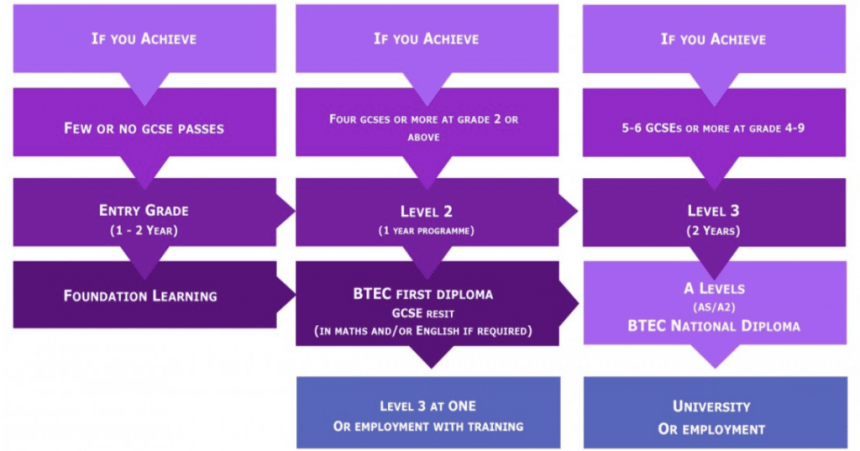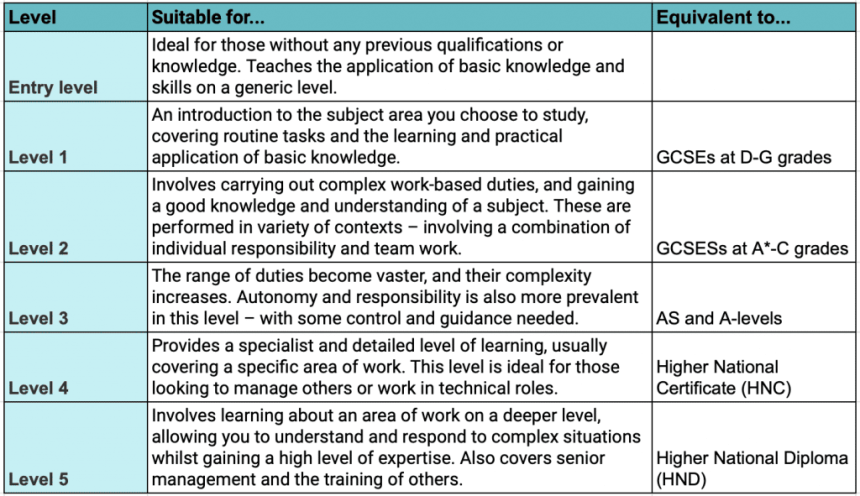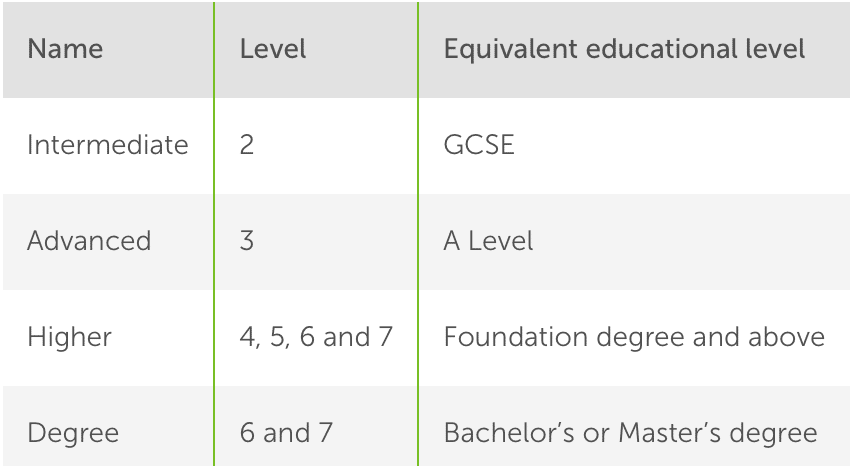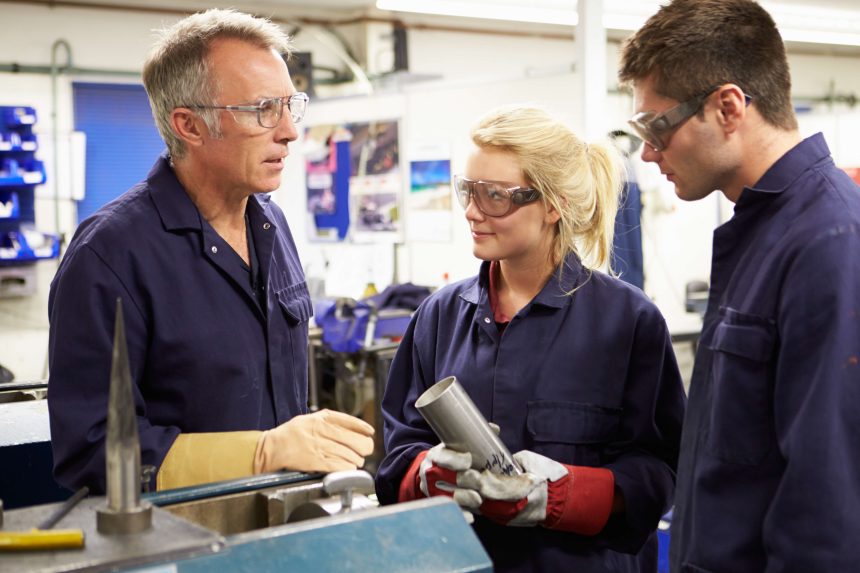Contents:
When you think of sixth form, A Levels are probably the first thing that springs to mind. This route can be good for students who are interested in academic subjects. However, for many students, this type of qualification may not be the best option.
Many students find it difficult to engage with traditional teaching methods, which typically include textbook-based learning, cramming, and recall, with a focus on written rather than practical assessments. As a result, by sixteen, many students may have decided that they don’t want to pursue these academic subjects further. Some may already know what they want to do as a career and intend to pursue that specialism now. Others may have non-academic talents or interests, and further education is a great chance for them to explore their passions while gaining qualifications. In both of these instances, vocational qualifications, which tend to be focused more on skills and their application in the workplace, are good options to explore.
What are vocational qualifications?
Vocational qualifications are hands-on. They teach students knowledge and skills relating to specific career areas and apply them within a work-based setting.
This article will explore three vocational qualifications your child can do instead of A Levels: BTECs, NVQs, and Apprenticeships. It should be noted that this is not an exhaustive list and there are other options available. For example, the government has recently launched new courses called T Levels, which follow on from GCSEs. A T Level is equivalent to 3 A Levels.
These qualifications should in no way be considered inferior to A Levels; they are a totally different kettle of fish. They are industry standards, approved qualifications, and robust assessments, equivalent to academic qualifications. A common misconception is that A Levels are the only route into higher education, and the only qualification type that will guarantee your child career success.
However, according to Pearson…
- In 2015, over 25% of students entering university in England did so with a BTEC qualification
- 90% of BTEC students were employed full time after graduation (Progression Pathways, 2016)
- A Level 3 BTEC qualification could boost lifetime earnings by £92,000 (London Economics, 2013)
BTECs, NVQs and Apprenticeships have many different levels, enabling students to begin at the level that suits them. If your child knows nothing about a particular area or role, they will start off at a lower level and move up as they gain experience. Once they have reached a certain level, they may be able to secure a job or they may continue studying to a higher level.
Your child shouldn’t focus too much on which levels are equivalent to which qualifications. Instead they should focus on which level will match their level of experience, or which level they can start at based on their GCSE grades.

BTECs
- Students are predominantly based in their sixth form or college
- The course includes hands-on industry work experience
- They can provide access to university
Levels of BTEC
Different levels of BTEC are equivalent to different qualifications; some to GCSEs and others to A Levels. If your child is going to study a BTEC instead of A Levels, it’s likely that they will apply to study for a BTEC National Diploma. These can be studied full or part-time, and alongside other qualifications.
Entry requirements
Like A Levels, BTECs have entry requirements. As such, your child may need to achieve certain GCSE grades in particular subjects to apply for a course. Requirements vary depending on the area of study and host institution.
Don’t despair if your child is struggling with their GCSEs and may not get the grades required to study for a BTEC National Diploma. There are many levels of BTEC available; your child could start on a lower level of BTEC and work their way up. The flow diagram below can give you an idea of various paths your child can take:

How are BTECs taught and assessed?
BTECs are predominantly based around classroom learning. This means that your child will spend most of their time at sixth form or college. Their course will include work placements, where they will apply what they’ve learnt in class to a real life setting.
Unlike A Levels, in which students study for two years and where the majority of assessments or exams occur at the end, BTECs are assessed periodically. The qualification is designed around a number of themed units, and students are assessed at the end of each unit and given a grade. These grades are averaged to give a final grade.
BTEC grades explained
When your child completes their BTEC Level 3 qualification (National Diploma) they will be awarded one of the following grades:
- D* – starred distinction
- D – distinction
- M – merit
- P – pass
The type of assessment at the end of each unit will depend on the subject or course. Your child may have coursework assignments designed to combine the theory learned in class with what has been learned on placements. There may also be practicals or written tests.
Subjects
There are so many BTECs on offer – the possibilities are endless. One approach is to look at the sixth forms or colleges near you offering BTECs and see if any courses interest your child.
Another approach is to find a course or area your child is interested in and then find a sixth form or college which teaches the course. For this option, it’s good to start off broad, bearing in mind your child’s interests, strengths, and weaknesses, and then narrow down the options. Research is key; the more research you and your child do now, the more you will know what the course will involve and whether they are likely to enjoy it.
Typical areas include:
- Art and design
- Business
- Healthcare
- Engineering
- IT and digital
- Performing arts
- Service industries e.g. hospitality and catering, travel and tourism
- Land-based industries e.g. construction
- Sport
- Science
What can your child do after a BTEC?
Once your child has completed their BTEC, there are many routes they can go down.
Get a job
Employers look to hire people who have industry-specific knowledge and skills: BTEC students have both. This makes BTEC students and alumni uniquely employable. According to Pearson, the qualifying body of BTEC:
“74% of employers want new hires with practical knowledge and skills combined, 90% of BTEC students are employed full-time after graduating, and 23% of students who went to university in 2018 had a BTEC.”
Go to university
A BTEC can be a good route into university if your child would like to pursue their chosen area further. Pearson states that:
“In 2016 nearly 1 in 4 students who got into university did so with a BTEC.”
In recent years, universities have noticed an increase in students with BTECs applying to university. Laura Kishore, Head of Admissions at Oxford Brookes University, says:
“We have seen a definite rise in the proportion of applicants with BTEC qualifications in the past few years. Also, now that BTEC Level 3 qualifications come in different sizes (i.e. not just the equivalent of three A Levels, but the size of two or even one A Level), we have seen an even bigger rise in the numbers of applicants offering both BTEC and A Level qualifications.”
The table below shows the UCAS and A Level equivalents to BTEC grades:

If your child intends to go to university, they should look at potential courses now so that they can check the entry requirements and get an idea of exactly what qualifications they will need to get onto the course of their dreams. It may not be as simple as having a BTEC, and now is a good time to find out what grades they will need to get there and if a BTEC alone will be enough.
The good schools guide says…
“A BTEC comprises of a set number of units. An 18-unit BTEC equates to three A levels, and many universities will accept it. But students applying to university who have a 12-unit BTEC may well be expected to have an AS or an A level too. It’s worth noting that 95 per cent of the UK’s universities accept BTEC Nationals as qualifications for over 70 percent of their degree courses.”
This block is currently empty. Please add some content.
National Vocational Qualifications (NVQs)
- NVQs are similar to BTECs in that they combine learning with industry experience
- This qualification demonstrates competence in a certain job or area
- NVQs can be studied as part of a job, at college, or as part of an apprenticeship
How are NVQs taught and assessed?
Unlike BTECs, which are classroom-based with placements, most NVQs are based in the workplace. Your child will likely be a full-time or part-time employee and will be completing their NVQ as they work. Another (but less common) option is taking an NVQ at a college with work placements to gain industry experience.
Like BTECs, most NVQs are divided into units. A candidate’s competency is assessed at the end of each unit. However, there are no exams! Instead, candidates put together portfolios, to provide evidence of what they’ve been doing and to show that they meet the required standards. Candidates are also observed doing certain tasks by an assessor who will grade them against an industry standard. They are assessed as being either ‘competent’ or ‘not yet competent’.
The biggest positive of an NVQ is that each unit is assessed only when the candidate is deemed ready to pass that unit. This flexibility sets students up for success. There is no pressure to pass an exam at the end of a set period of time, enabling students to learn at their own speed.
NVQ levels
There are five levels of NVQ (not including entry level). Each involves the teaching and application of particular work-based competencies. If your child has no experience, they will generally start off at a lower level in order to gain experience.
NVQs are available at Levels 1 to 5. Level 2 and 3 NVQs are also available as part of an apprenticeship.

Your child can take as long as they want to do each level. Generally, however, most learners take about one year to complete an NVQ at Level 1 and 2, and around two years for an NVQ at Level 3. Levels 4 and 5 are much higher qualifications and are equivalent to degree level.
Subjects
Your child can do an NVQ in a range of different areas. According to the Good Schools Guide, the most popular NVQ subjects are in:
- Administration and management
- Beauty and hairdressing
- Care of the elderly and children
- Catering
- Construction
- Communications
- Design
- Plumbing
- Social Care
- Travel and tourism
You can search NVQ courses on the NVQ courses hub website. This will give you an idea of the range of options available to your child. Once they have found an area or specific qualification which interests them, they should research places that offer them. They may take an NVQ through a college or through employment.

What can your child do with their NVQ?
It’s likely that your child will have gained their NVQ as part of their employment. Being more skilled in their line of work will not only give them better job satisfaction, but will also afford them more opportunities to progress in their career. With an NVQ to their name, an employer’s confidence in your child’s ability may increase. They may be given more responsibility or even a promotion. Furthermore, if your child decides to change company, having a formal qualification will make it easier for them to find employment.
If your child completes their NVQ in a college and isn’t yet employed, their qualification will make them more attractive to employers.
Go to university
An NVQ at Level 3 is the equivalent of an A Level. Some NVQs are recognised by universities.
According to NI Direct:
If you’ve achieved an NVQ at Level 3, you could also go on to a higher education course in a related vocational area such as:
However, it’s important to research courses and entry requirements carefully. Your child shouldn’t be afraid to pick up the phone and call the admissions office; they will be more than happy to discuss what qualifications are needed for their courses.
Apprenticeships
- Your child will earn while they learn
- 80% of time is spent on placement with the remainder in college studying
Apprenticeships are similar to both BTECs and NVQs in that learning is very much centred on practical knowledge and the application of skills. Around 80% of your child’s time will be spent on placement. The remaining time will be spent at a place of study. This means students need to have good time management skills and be able to balance the two aspects of their course.
The biggest difference between apprenticeships, and BTECs and NVQs done through a college, is that apprentices are paid while they learn. Apprentices are employed for the duration of their apprenticeships and even get holiday pay. What your child will earn depends on their age, which part of the country they are in, and which apprenticeship they are undertaking.
Apprentices should work for a minimum of 30 hours a week and a maximum of 40 hours. Time spent off the job at a college or in training is included in this time.
Subjects
Like BTECS and NVQs, your child can do an apprenticeship in a huge range of sectors. According to the government, in 2018/2019 “83% of all starts were in four subject areas: Business, Administration and Law; Health, Public Services and Care; Engineering and Manufacturing Technologies; and Retail and Commercial Enterprise.”
Finding an apprenticeship
There are many ways of finding an apprenticeship:
- The government has a ‘find an apprenticeship’ service on their website.
- Your child can contact the National Apprenticeship Helpdesk on 0800 015 0400 or by email: [email protected]
- The Amazing Apprenticeships YouTube channel has useful hints and tips on applying plus other videos on apprenticeships; simply visit YouTube and search apprenticeships/NAS.
- Your child may also be able to contact local businesses and ask if they would be interested in taking on apprentices.
Once your child has found an apprenticeship that they are interested in, they should register through the government website and apply. Applications are similar to filling out a CV. Your child should take time to work out what they will write in each box. If applying for multiple apprenticeships (it’s best for your child to apply for a few options in case they don’t get their preferred choice), they need to ensure that what they write is specific to the role they’re applying for: they shouldn’t just copy and paste!
Apprenticeship levels
There are four levels of apprenticeship: Intermediate, Advanced, Higher, and Degree. The entry requirements vary depending on the level applied for.

Apprenticeships can take different lengths of time to complete − anything from one to six years depending on the level and area of study. Like NVQs, it is often possible to progress onto higher level apprenticeships.
How are apprenticeships taught and assessed?
If your child chooses to become an apprentice, their time will be split between on-the-job training (80%) and classroom-based college learning (20%).
Assessments are usually carried out by the training provider, and externally assured by an awarding organisation for recognised qualifications. Your child will ‘achieve’ an apprenticeship; there aren’t any pass marks [such as merit or distinction]. The way in which apprentices are assessed depends upon what is being studied.
Methods may include:
- Practical assessment
- Interview
- Project
- Written and/or multiple-choice tests
- Presentation
Some apprenticeships require an assessment at the end of study, known as an end-point assessment (EPA).

Which qualification to pick and how to narrow down your child’s options
BTECs, NVQs, and Apprenticeships provide practical routes into work. Their hands-on approach is especially suited for practical people who prefer doing things instead of spending hours reading about them. When considering a course, your child should focus on factors that are important to them: do they find the industry interesting and does the style of teaching and assessment suit them?
What industry?
If your child is fanatical about bikes and cycling, they could find an apprenticeship as a bike mechanic. If your child loves working with young children, they could do an NVQ in childcare. If they’ve always dreamed of working in a pharmacy, they could become an apprentice pharmacy assistant. BTECs, NVQs, and Apprenticeships are all possible in the majority of sectors. Your child should pick a passion and work from there.
You may feel that going down a vocational route is a big gamble. Maybe the closest your child has ever got to being an electrician is making a moisture detector in D&T in Year 8. Or maybe your child loves doing nails and makeup, but that’s a far cry from becoming a beautician. You have no idea if their interest will last out a two-year course and eventual career. A good way for your child to test out their passion is to try and get some work experience in the industry. For example, if your child loves styling hair, they could enquire at their local hairdressers to see if they could do some work experience.
Which qualification?
There is a lot of overlap in terms of the qualifications available in each industry. For example, you can do a BTEC in Engineering, NVQs in Engineering, and Engineering Apprenticeships. Which type of qualification your child decides on should be determined by their strengths, character, and the form of learning and assessment that will best suit them.
Things to consider:
- What type of learner is your child? If they don’t like sitting in a classroom, then a BTEC may be low on their list.
- Are they motivated by money? In which case they may be drawn to an apprenticeship or want to do an NVQ as part of a job.
- Do they want to go to university? If so, a BTEC may be the best option.
- Do they want to work for a particular company? What qualifications do they need to do this? Or, can your child do an apprenticeship or NVQ with them?
If your child is still unsure of what to do, UCAS has a short quiz to help them determine which qualification types would suit them best.
There are many options for you and your child to explore. The most important thing to do is to thoroughly research all of their options and then narrow down the list based on factors that they deem important. These could be as simple as which option is closer to your home for an easy commute, which assessment format or teaching style will suit them better, or which college or company your child would prefer to do their qualification with. There’s a plethora of options in a whole range of fields, each able to provide your child with a qualification to further accelerate their career path and give them the option to progress onto university. With just a little research and careful consideration, your child can look forward to fulfilment and success.







Comments